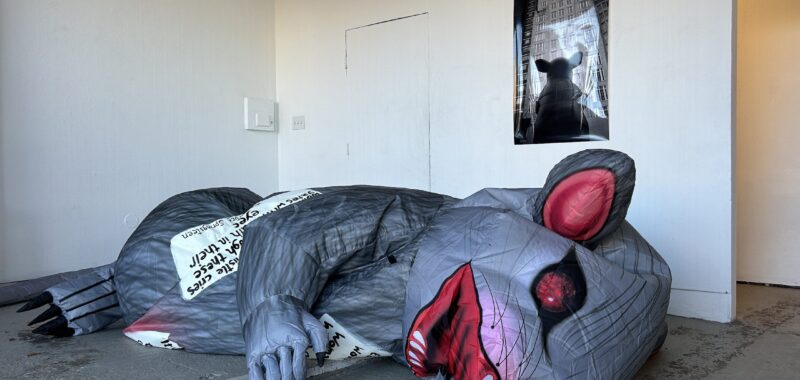Scabby the Rat is a signature symbol of organized labor in the United States. The larger-than-life inflatable rodent with bloodshot eyes, spikey claws, and snarling incisors is a familiar sight at union pickets, where his presence signals workplace mistreatment and strikebreaking to the greater public.
Now, Scabby is the centerpiece of the ongoing exhibition Scabby: A Rat About Town by Austrian artist Marlene Hausegger. On view at South Slope’s Open Source Gallery through November 29, the installation combines black-and-white photographs lacerated with mock rat scratches; audio excerpts from former Amazon worker and present-day union activist Natalie Monarrez; and, naturally, an inflatable Scabby, covered in words pulled from Bruce Springsteen’s 1978 song “Factory.” Painted across the rat’s torso and legs, the lyrics have been edited to reference women instead of men.
Hausegger told Hyperallergic that she became intrigued with Scabby when she initially came across the character in 2008 while visiting New York City.
“I saw this blow-up rat for the first time and to me, it was a very dramatic and strong visual of injustice,” Hausegger said.

While doing research into Scabby, Hausegger and the gallery’s director Monika Wuhrer learned that the inflatable rats used at union actions across the country all can be traced back to a single manufacturer in Illinois called Big Sky Balloons. (Ironically, the business that fabricates the labor rights advocacy icon is not unionized itself.)
“It’s a very profitable business and the Scabbies are really, really expensive,” Wuhrer told Hyperallergic, admitting that for the exhibition, they ultimately had to turn to a cheaper option produced overseas.
“We ended up ordering it from China because it was really the only way to have one in the end,” Wuhrer said.
At Open Source, the visual impact of Scabby is striking, with the rat taking up half the floor of the gallery space. It is especially eye-catching when it intermittently deflates every 15 minutes, its collapse timed with Monarrez’s testimony about the unfair labor practices she experienced while working at Amazon’s JFK8 facility in Staten Island. After seven years, she was terminated from her position last month, along with other unionized workers, she told Hyperallergic. And while organizing with fellow employees was crucial to fighting for fair working conditions, she noted that unions are not immune to issues that can run rampant in workplaces, including racism, sexism, ageism, homophobia, and corrupt leadership.

“I think that’s probably why only 10% of American workers are actually in unions right now, which is a shame,” Monarrez said. She recalled the first time she saw Scabby, eight years ago, also in New York City.
“I do remember instantly thinking, ‘There must be an issue between the workers and the employer,’” she said.
The rodent’s name and its “scabby” belly come from the term “scab,” a derogatory nickname for workers who break a strike. “It’s an all encompassing symbol, depending on what your perception is and what your experience is within your union and your workplace,” Monarrez said.
Monarrez is one of several unionized Amazon workers featured in the 2024 documentary Union directed by Brett Story and Stephen Maing, which will screen at Open Source Gallery on November 20. The screening, which is a free event with a suggested donation, will be followed by a conversation with the film’s producer Mars Verrone and Labor Arts Director Rachel Bernstein.

